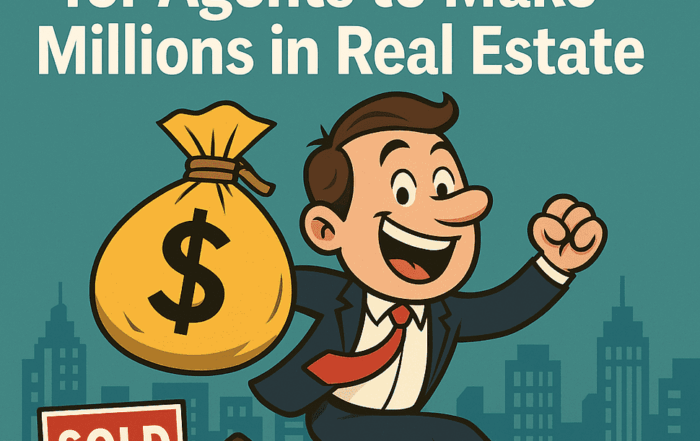
Return on Equity in Real Estate
Let’s talk about Return on Equity (ROE) in real estate—but don’t worry, we’re keeping it simple. If you can understand why a piggy bank full of quarters isn’t making you rich, you’ll get this!
What Is Return on Equity (ROE)?
Picture this: You own a rental property worth $200,000. Over time, you pay down your mortgage and build up $150,000 in equity (that’s your ownership part). But here’s the kicker—if your property is making $5,000 per year in profit, your return on that $150,000 is just 3.3%. That’s your ROE!
The Math (Don’t Run Away!)
ROE Formula: Net Profit ÷ Equity = ROE
In our example: $5,000 ÷ $150,000 = 0.033 or 3.3%
Why Does ROE Matter?
Imagine you’ve got that $150,000 locked up in your property, working like a lazy teenager who only earns $5,000 a year. Could that money work harder elsewhere? If so, it might be time to put your equity to work!
How to Boost Your ROE:
-
Refinance and Pull Cash Out: Take some equity out, buy another property, and increase your cash flow.
-
Sell and Reinvest: Sell your property, use the profits to buy something with higher returns.
-
Improve the Property: Raise rent or add value, so your profit grows without needing more cash.
-
Pay Attention to Leverage: Sometimes using a mortgage can improve your return on equity compared to having a property fully paid off.
Digging Deeper into Return on Equity
Understanding ROE is not just about knowing the formula. It’s about grasping how your equity can either be a superhero or a couch potato in your wealth-building journey. Here’s a deeper dive into why ROE is crucial and how seasoned investors view it:
-
Equity is a Sleeping Asset: Equity in a property often grows over time as you pay down your mortgage and property values increase. That’s great, right? Sure, but equity alone doesn’t put cash in your pocket. If you’re sitting on $200,000 of equity and only making $6,000 a year, your ROE is 3%. You could potentially put that $200,000 into multiple properties or other investments and earn 8-12%.
-
Evaluating Opportunity Cost: Every dollar locked in equity is a dollar that could be working somewhere else. Investors often compare their ROE with other opportunities. If a different property, stock, or business could bring a 10% return, your current 3% ROE property might be dragging you down.
-
Equity Trap: It feels good to have a paid-off property or one with loads of equity, but it can trap you into thinking you are doing well when your money could be working harder elsewhere. Smart investors check their ROE regularly and aren’t afraid to shuffle their portfolio.
-
Growth vs. Stability: Some investors are okay with a lower ROE because they value stability and passive income. That’s fine if you’re nearing retirement. But if you’re in growth mode, low ROE is a warning sign that you need to make a move.
Real-Life Examples:
Example 1: John bought a rental house in Tampa for $100,000. Over 10 years, the property value increased to $300,000. John paid down his mortgage, and now he has $250,000 in equity. The property makes him $7,500 a year in cash flow. His ROE is 3%. John decides to refinance, pulls out $150,000, and buys two more rental properties. Now his cash flow is $22,500 across all properties, and his ROE jumps to 9%.
Example 2: Sarah owns a duplex in Orlando with $200,000 in equity. Her annual cash flow is $6,000, making her ROE 3%. She sells the property and does a 1031 exchange into a triplex. The triplex generates $15,000 annually, boosting her ROE to 7.5%.
Common Mistakes to Avoid:
-
Ignoring ROE for Too Long: It’s easy to get comfortable when tenants pay rent on time, but that doesn’t mean your equity is working its hardest.
-
Over-Leveraging: Refinancing is great, but don’t pull so much equity that you end up cash flow negative. Balance is key.
-
Underestimating Costs: Selling or refinancing can involve costs like taxes, fees, and closing costs. Always factor those in when calculating your potential ROE.
-
Focusing Only on Cash Flow: Cash flow is king, but ROE is the kingdom. You want both.
Practical Steps to Take Right Now:
-
Calculate Your ROE:
-
Look at your net profit.
-
Divide it by your equity.
-
If it’s under 5%, consider your options.
-
-
Talk to a Mortgage Broker:
-
Explore cash-out refinancing.
-
-
Research New Investment Opportunities:
-
Look for properties or markets offering higher returns.
-
-
Review Annually:
-
Make ROE review part of your yearly financial checkup.
-
Pro Tip: Stress Test Your Rentals
My thought is to keep as much money out as your rental stress test allows, just in case the rents drop by 30%. This way, you have the reserves or lower leverage to withstand tough times while still keeping your money working hard in other investments.
Conclusion:
Return on Equity is your financial report card. Don’t let your equity snooze while you work hard. Make it hustle, grow, and help you build lasting wealth.
Pick your expert. Book your free 15-minute consult now. We are here to help!
Our Top Articles
Why You Should Sell Your Deals with Us
Jorge Vazquez2025-08-02T03:43:24+00:00August 2nd, 2025|Comments Off on Why You Should Sell Your Deals with Us
Let’s keep it real—wholesaling ain’t easy. You lock up a deal, hustle to find a [...]
Landlords, Listen Up: Florida’s A+ Economy Is Coming—Here’s Why 2025 Still Makes Sense
Jorge Vazquez2025-08-01T19:53:23+00:00July 31st, 2025|Comments Off on Landlords, Listen Up: Florida’s A+ Economy Is Coming—Here’s Why 2025 Still Makes Sense
Florida’s A+ Economy in 2026: What This Means for Landlords, Renters, and Real Investors Like Me By Jorge Vazquez, [...]
What It Really Takes for Agents to Make Millions in Real Estate
Jorge Vazquez2025-08-01T01:32:51+00:00July 31st, 2025|Comments Off on What It Really Takes for Agents to Make Millions in Real Estate
What It Really Takes for Agents to Make Millions in Real Estate Inspired by a Fellow Featured Agent—Kat Palmiotti [...]
Property Profit Academy:
✔ Learn to buy properties with little to no money down.
✔ Build a $10M portfolio step by step.
✔ Master strategies like BRRRR and house hacking.








